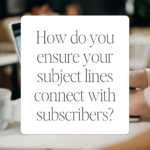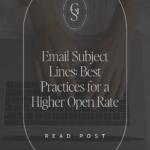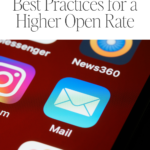
Email Subject Lines: Best Practices for a Higher Open Rate
Table of Contents
ToggleSharing is caring!
Reading Time: 4 minutes


First impressions are EVERYTHING in email marketing. The subject line is the first thing readers see when receiving your email. This means you must make a great impression through the subject line, or else, most won't bother opening your marketing messages. Worse, your emails could be flagged as spam, and your marketing messages will be blocked by either the user or the email platform.
Every marketing message you send to subscribers has to count. Otherwise, you're wasting time and precious resources on an ineffective marketing campaign. And it's not enough to come up with catchy subject lines. You must observe the best practices to connect with your readers and encourage them to open your messages and engage with your emails.

Email Subject Lines: Best Practices for a Higher Open Rate
Personalise the Subject Lines
Readers will only make a connection with a marketing message if they relate to the subject line. Your subject line has to “click” with your readers – they won't open emails if they know they're not the target audience.
They might unsubscribe from your marketing messages if the subject lines give the impression that they're irrelevant to the recipients. To improve your chances of success, personalise the subject lines by:
- Addressing the recipient by name
- Including the recipient's interest, location, or purchase history in the subject line
- Mentioning the products that the readers showed interest in
Personalisation is effective, but stay moderate with it. Adding personal details to the messages may come off as intrusive.
Compel Readers to Take Action
A clear call to action (CTA) in the subject line encourages readers to take the desired action. The desired action can be anything from buying a product or upgrading to a higher-tier product/service.
For instance, if you're launching a new product, your subject line could read, “Be the first to try our newest product – here's your 10% off discount voucher.” This subject line persuades readers to purchase anyone else by offering a discount.
Conversely, action-oriented subject lines tend to sound spammy if you're overdoing with the CTAs. Your readers won't take your offer if the message reads too sales pitch-y. So, experiment with different CTAs and choose persuasive ones without being too pushy.
Be Direct
Be descriptive and direct with your subject line to hook readers immediately. It's fun to devise creative ways to convince readers to take an action, but being straightforward removes any confusion over what they must do to accept your offer.
Letting readers guess what you want them to do with the information you just presented in their email will lead to dismal results. A subject line should have a specific hook. Otherwise, readers will lose interest. Throwing a compelling stat, focusing on the value, and using descriptive words help convey precisely what your email is about, something that many readers will appreciate.
Use Emojis, Punctuation Marks, and Special Characters Sparingly
Punctuation marks and emojis are used to express strong emotions or add a bit of fun to the subject line, but using too many of these will impact an email negatively.
- Too many punctuation marks can make an email appear spammy
- Too many emojis will distract readers from the core message of the email
- Special characters and emojis can mess up the formatting of the subject line
- Some OS render emojis and special characters differently. So, using these requires a lot of testing.
Use emojis sparingly; these should never replace supplement words. One emoji in each subject line is plenty enough. Use up to three punctuation marks so the message will appear smooth and enthusiastic. Most importantly, never skip testing to ensure your email messages – including the subject lines – appear exactly how you want them to.
Add a Preview
Adding a preheader text, which goes under the subtitle of the email, to give more detail at a glance. This way, your readers will get an idea of what the email is about at a glance and click the message to read the entire message. A compelling stat, a relatable term, or interesting words could be used as a “hook” in the preview to increase the chances of success.
Proofread Before Hitting Send
Regardless of whether you're sending emails manually or using an automation tool like Flodesk, do not skip proofreading. You might miss excess spacing, incorrect caps, or typos. Avoid spammy or clickbait terms of any kind because these can put people off, terms such as:
- 100% free
- Click here
- Get it now
- Limited time offer
- Best/Bargain Price
- Extra Income
- Certified
- Act now!
Clickbait terms will trigger the spam filter; if that happens, subscribers might miss out on your email content entirely. Worse, your marketing messages could end up in the spam folder, never seeing the light of day.
Look at Your Own Inbox
What compels readers to click an email? Many factors come into play, but an effective strategy is to check your inbox and see how other marketers are doing it. Which subject lines are more effective for you? If you see great ones used by other brands, go ahead and snag them. Adapt by matching it with your brand voice.
If you've already got a list of great-looking subject headlines and are still not seeing great results, other factors may be affecting your campaign.
- Check how the messages look on different screens.
- Be mindful of the frequency – do not send messages daily, or these will be ignored.
- Figure out the best times to send emails, and avoid odd hours or long weekends.
- How targeted is your email list? Revisit your list and see which ones are genuinely interested in your marketing messages.
While there are many reasons why some marketing messages aren't resonating with your target audience, it's worth experimenting with different strategies to get the best results. And with the tips outlined above, you'll gradually build a brand that people will trust.
Most Popular Posts:
Sharing is caring!
PLEASE COMMENT BELOW